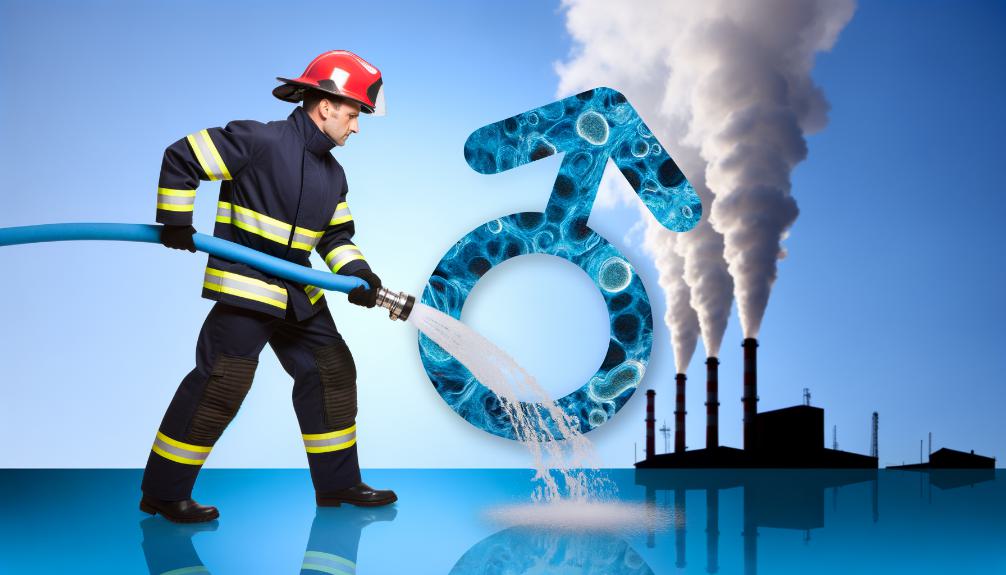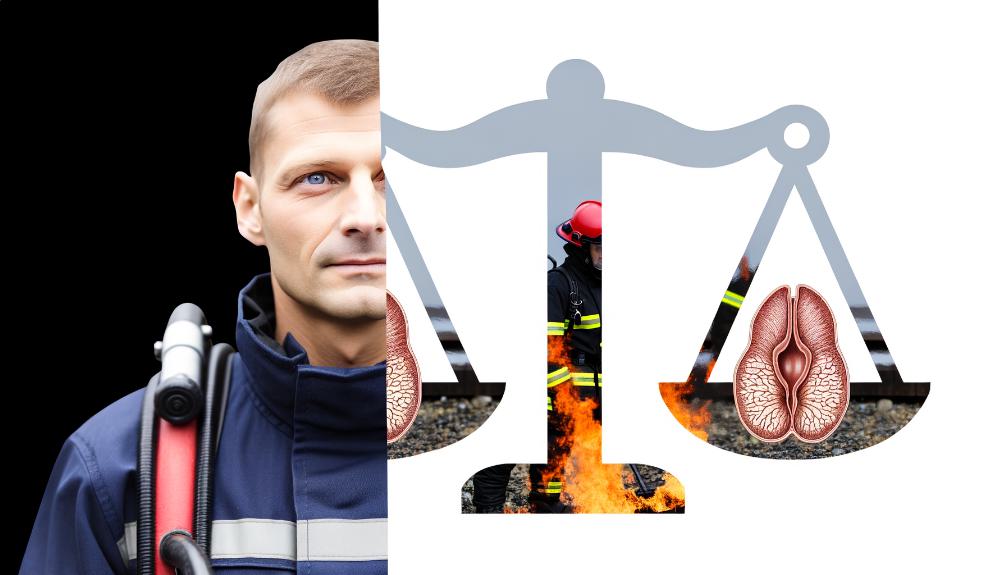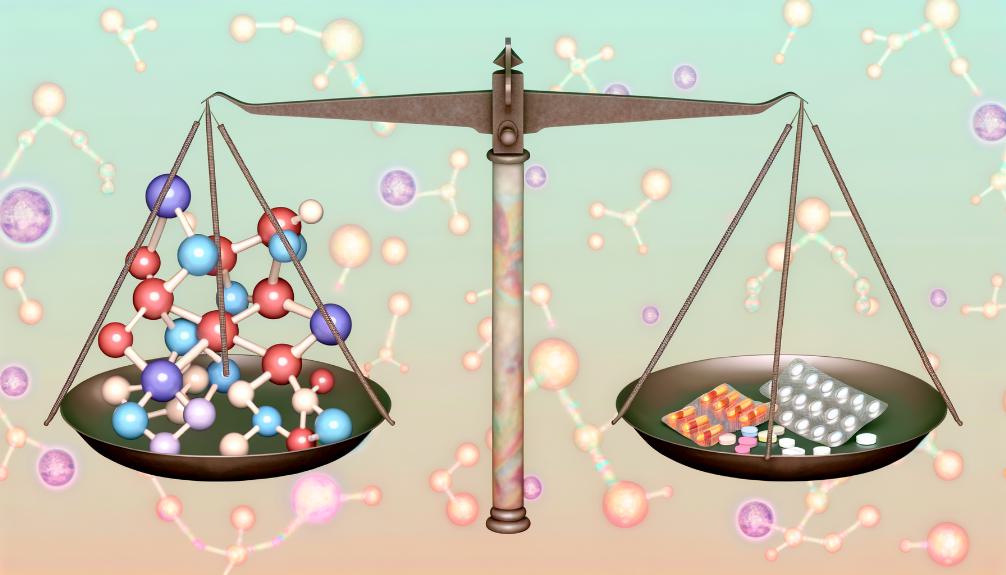Prostate Cancer Causes That May Affect AFFF Case Value
We're delving into the intricate relationship between prostate cancer causes and AFFF case values. Firefighters face a heightened risk due to exposure to PFAS chemicals in AFFF, which have been linked to DNA damage in prostate cells and an increased risk of developing the disease. The evidence underscores not just a critical health crisis but a pressing legal issue, with affected individuals seeking compensation. Understanding the legal nuances, including proving exposure and harm, is essential. Our analysis highlights the importance of federal health assessments in shaping case outcomes. This knowledge is pivotal for those pursuing legal recourse, offering a foundational understanding of the intricacies involved in AFFF-related cases. By exploring further, one can grasp the profound implications for affected firefighters and their families.

Key Takeaways
- Occupational exposure to PFAS in AFFF increases the risk of developing prostate cancer.
- Genetic predispositions can influence the susceptibility to prostate cancer from AFFF exposure.
- The degree of AFFF exposure and duration can affect the severity of prostate cancer.
- Federal health assessments linking AFFF exposure to prostate cancer can impact case value.
- Documentation of AFFF exposure and resulting health issues is crucial for legal claims.
Understanding Prostate Cancer

Over the years, we've noticed that prostate cancer, a type of cancer developing in the prostate gland, greatly impacts men's health. This condition, part of the male reproductive system, has seen its understanding evolve, especially in recognizing the factors that may elevate an individual's risk. It's vital to acknowledge that elements such as age, family history, and race greatly contribute to the likelihood of developing prostate cancer. These risk factors underscore the importance of early detection and the implementation of preventative measures.
Symptoms associated with prostate cancer, including urinary problems, blood in the urine, erectile dysfunction, and bone pain, further emphasize the need for awareness and prompt action. Diagnosing this disease involves specific tests, such as PSA (prostate-specific antigen) blood tests, digital rectal exams, and prostate biopsies, which play pivotal roles in identifying the condition early on.
In terms of treatment, options vary and may include surgery, radiation therapy, hormone therapy, chemotherapy, and immunotherapy. The choice of treatment is often tailored to the individual's specific condition, taking into account the stage of the cancer and any other health considerations.
Understanding the nuances of prostate cancer, including the risk factors and exposure to potential carcinogens, is fundamental. It lays the groundwork for informed decisions regarding health and treatment options, reinforcing the critical nature of this knowledge in managing men's health effectively.
Firefighters Increased Risk
While understanding prostate cancer's basics is important, we must also focus on specific risk factors, such as the increased risk firefighters face due to occupational exposure. Firefighters, due to their line of work, are at a considerably heightened risk of developing prostate cancer. Studies indicate that firefighters have a 28% higher chance of being diagnosed with this condition compared to the general population. This alarming statistic underscores the need for awareness and preventive measures within this occupational group.
The link between firefighters and an increased prostate cancer risk is primarily attributed to their occupational exposure to per- and polyfluoroalkyl substances (PFAS), which are chemicals found in various firefighting foams (AFFF). These substances have been associated with a range of health issues, including cancer. The relationship between PFAS exposure and prostate cancer is particularly concerning, given the widespread use of PFAS-containing foams in firefighting activities.
Investigations have shown a correlation between regions with high PFAS contamination and increased rates of prostate cancer. For instance, a study in Kent County, MI, revealed a higher prevalence of prostate cancer among residents exposed to elevated levels of PFAS. This evidence suggests that both genetic predispositions and environmental exposures, such as PFAS in AFFF, play a significant role in the risk of developing prostate cancer.
It's evident that firefighters' occupational exposure to PFAS places them at a higher risk for prostate cancer. Recognizing and addressing this risk is crucial in protecting the health and well-being of these essential members of our communities.
PFAS: A Toxic Concern

As we delve into the important health concerns surrounding PFAS, it's vital to understand the ways in which exposure occurs and the significant impacts on health. These chemicals, particularly present in AFFF, have been directly linked to severe health issues, including an increased risk of prostate cancer among firefighters. Our focus on the exposure routes and health implications aims to shed light on the urgent need for stricter regulation and protective measures against these toxic substances.
PFAS Exposure Routes
Understanding the various routes through which PFAS can enter our bodies is essential for mitigating its harmful effects. The primary PFAS exposure routes include ingestion of contaminated water, inhalation of contaminated air, and dermal contact with surfaces that have PFAS on them. Specifically, firefighters face significant risk as they can be exposed to PFAS through AFFF during firefighting activities. This exposure is particularly concerning given the potential health risks, including prostate cancer. Additionally, our everyday environment contributes to our overall exposure levels through food packaging, household products, and industrial emissions. The persistence of PFAS in both the environment and the human body highlights the urgent need for us to address these exposure routes to minimize health risks.
Health Impacts of PFAS
The health implications of PFAS exposure, especially in connection to cancer risks like prostate cancer, are a growing concern for communities worldwide. These toxic chemicals, including PFOA and PFOS found in AFFF, are notorious for accumulating in the body, impacting various tissues. We've learned that PFAS can disrupt hormonal function and contribute to carcinogenic effects, which elevates the risk of developing prostate cancer to a high degree. Accumulative exposure to these substances underscores the urgency for stricter regulation. It's clear that mitigating the health impacts of PFAS exposure is essential, not just for those directly affected by prostate cancer, but for the broader community seeking to minimize exposure to these hazardous chemicals.
AFFF and Prostate Cells
Exploring the impact of AFFF exposure, we find that it can lead to DNA damage in prostate cells, greatly increasing the risk of developing prostate cancer. This connection is crucial for individuals who've been exposed to Aqueous Film Forming Foam (AFFF), primarily used in firefighting. The PFAS chemicals, particularly PFOA and PFOS found in AFFF, are particularly worrisome due to their ability to accumulate in prostate tissue, affecting cell function and integrity. We've learned that these chemicals can instigate changes in prostate cell proliferation and apoptosis, processes essential for maintaining healthy tissue.
Moreover, the development of prostate cancer may be significantly affected by PFAS-induced cellular changes in the prostate. It's not just about the accumulation of these chemicals but how they interact with cellular mechanisms, leading to a disruption in normal cell behavior. The damage to prostate cells from AFFF chemicals like PFAS contributes directly to the carcinogenic process, underscoring the gravity of exposure risks.
Understanding the biological mechanisms at play provides a clearer picture of why AFFF exposure is a serious concern. The studies showing a correlation between AFFF exposure and adverse changes in prostate cells highlight a need for awareness and caution. For individuals exposed to AFFF, these findings underscore the potential health implications, particularly the increased risk of prostate cancer. It's clear that the interaction between PFAS chemicals and prostate cells is a critical area of concern, with significant implications for both health outcomes and legal considerations in AFFF-related cases.
Epidemiological Evidence

Examining the epidemiological evidence, we've uncovered a vital correlation between AFFF exposure and an increased risk of developing prostate cancer among firefighters. Studies have consistently shown that firefighters with occupational exposure to AFFF have a notably higher prevalence of this type of cancer. This is particularly concerning given the important role firefighters play in our society, constantly facing dangers that go beyond the flames.
The research points to PFAS chemicals in AFFF as a contributing factor to DNA damage in prostate cells, potentially leading to cancer. These findings are crucial for understanding the health risks that firefighters face due to exposure to these hazardous substances. Compared to the general population, firefighters exposed to AFFF may face a 28% higher risk of developing prostate cancer. This statistical evidence underscores the severe impact that occupational exposure to harmful chemicals can have on the health of these essential workers.
The association between AFFF exposure and an increased risk of prostate cancer is not only supported by anecdotal evidence but is also firmly grounded in scientific studies and epidemiological data. The consistent findings across various studies highlight the pressing need for addressing the health risks associated with AFFF exposure among firefighters.
As we investigate the complexities of how these chemicals contribute to an elevated risk of prostate cancer, it becomes increasingly clear that the firefighting community is facing a significant health crisis. The evidence calls for immediate action to mitigate these risks and protect our firefighters from the long-term health consequences of AFFF exposure.
Federal Health Assessments
In our exploration of how prostate cancer cases tied to AFFF exposure are valued, we've come to understand the pivotal role of federal health assessments. These assessments have made clear the link between AFFF exposure and an increased risk of prostate cancer, especially among firefighters. They not only provide a foundation for evaluating case value but also underscore the impact of PFAS chemicals on health outcomes.
Health Assessment Overview
Federal health assessments are essential for understanding the link between AFFF exposure and the increased risk of developing prostate cancer. These assessments explore the relationship between PFAS chemicals, found in AFFF, and the onset of prostate cancer, providing key insights. By analyzing this vital data, we're able to grasp the potential health implications and risks tied to AFFF exposure. Adhering to federal guidelines, these health assessments play a pivotal role in guiding decision-making processes, especially in legal contexts related to AFFF exposure. The findings from these evaluations don't just shed light on the risks but also greatly influence the evaluation process of AFFF-related prostate cancer cases, underscoring their importance in the broader legal landscape.
Impact on AFFF Cases
Understanding the link between AFFF exposure and prostate cancer, we now focus on how these federal health assessments impact AFFF cases. The confirmation of AFFF chemicals, especially PFAS, as significant contributors to prostate cancer is pivotal. These assessments have shown a direct correlation between AFFF exposure and the development of prostate cancer, highlighting the role of PFAS in causing DNA damage in prostate cells. This evidence is vital in evaluating prostate cancer cases for compensation, emphasizing the importance of recognizing AFFF exposure's health implications. It's clear that these federal health assessments are instrumental in strengthening the legal arguments for those affected, ensuring that the impact of AFFF exposure on health, particularly prostate cancer, is adequately considered in legal proceedings.
Military Use of AFFF

For decades, the military has relied on AFFF containing harmful PFAS for firefighting, leading to significant environmental and health concerns. The widespread use of AFFF on military bases, ships, and aircraft was primarily to extinguish fuel-based fires effectively. However, this military use of AFFF has led to widespread PFAS contamination at numerous military sites. These substances, known for their persistence in the environment and potential health risks, have drawn considerable attention.
We've come to understand the gravity of the situation as specialized studies continue to shed light on the health implications and environmental impact of AFFF use in the military. This evolving awareness has prompted military regulations to adapt, phasing out PFAS-containing foams in favor of safer alternatives. The goal is to mitigate the environmental and health risks associated with these substances, marking a significant shift in how firefighting efforts are approached within military operations.
The journey toward understanding and addressing the repercussions of AFFF use in the military is ongoing. The challenges are manifold, involving not just the implementation of new firefighting methods but also grappling with the legacy of PFAS contamination. Ensuring the safety of military personnel and the protection of the environment remains a paramount concern as we navigate these changes.
As we move forward, the commitment to reducing health risks and environmental impact is clear. The military's proactive stance in phasing out PFAS-containing AFFF and adopting safer alternatives is a positive step towards addressing the concerns that have emerged from decades of AFFF use.
Recognizing Early Symptoms
As we examine the impact of AFFF use in the military, it's important to also recognize how exposure to harmful substances like PFAS can heighten the risk of health issues, such as prostate cancer, underscoring the importance of being vigilant about its early symptoms. The use of toxic firefighting foam has been a significant concern, with links to various health problems, including a heightened risk of prostate cancer. Recognizing the early symptoms of this disease is crucial for improving treatment outcomes.
Early symptoms of prostate cancer include frequent urination, especially at night, and difficulty starting or stopping urination. These signs may seem benign at first, but they can indicate a deeper, more serious issue. Blood in the urine or semen is another alarming early sign that should not be ignored. Additionally, pain or discomfort in the pelvic area may indicate the onset of prostate cancer. It's vital to understand that these symptoms should prompt immediate medical consultation.
We emphasize the importance of recognizing these early symptoms as part of a proactive approach to health, especially for those who have been exposed to AFFF. The connection between toxic firefighting foam and prostate cancer makes it imperative for individuals to be aware of the potential risks and to monitor their health closely. Early detection and addressing these symptoms can significantly improve the chances of successful treatment, highlighting the need for ongoing awareness and vigilance in monitoring one's health, particularly for those with a history of AFFF exposure.
Diagnostic Procedures

We'll explore the critical diagnostic procedures for prostate cancer, including PSA screening, digital rectal exams, and imaging studies, essential for identifying the disease's stage and aggressiveness. These steps are pivotal in our journey to understand how prostate cancer can impact AFFF case value. Importantly, the prostate biopsy stands out as a common diagnostic tool. It's not just about confirming the presence of cancerous cells; it's about getting a clear picture of what we're dealing with.
These diagnostic procedures aren't just essential steps; they're our gateway to early detection. We've learned that catching prostate cancer early significantly improves the chances of successful treatment and a favorable prognosis. It's a critical point we emphasize to our clients, as early detection directly correlates with better postoperative outcomes. After all, understanding the stage and aggressiveness of prostate cancer through these procedures allows us to tailor a treatment plan that's both effective and less burdensome for the patient.
Monitoring postoperative outcomes becomes another vital aspect of our approach. It's not just about getting through surgery; it's about ensuring the path to recovery is as smooth as possible. This ties back to the importance of diagnostic procedures. If we have a clear understanding of the exact nature of the prostate cancer we're dealing with from the start, we're better equipped to predict and manage postoperative outcomes.
Active Surveillance Strategy
Active surveillance, a patient-centric approach for managing low-risk prostate cancer, prioritizes regular monitoring over immediate, aggressive treatments. This strategy is particularly beneficial for men diagnosed with low-risk prostate cancer, offering an alternative that focuses on observation rather than diving straight into treatments that can carry noteworthy side effects. Through active surveillance, patients undergo regular check-ups, PSA tests, and biopsies, allowing healthcare providers to closely track the cancer's progression without rushing into potentially unnecessary interventions.
We've come to understand that this approach not only helps in avoiding the undue stress and complications associated with more aggressive treatments but also significantly contributes to a better quality of life for those diagnosed with low-risk prostate cancer. The emphasis on monitoring rather than immediate treatment helps in preventing overtreatment and the associated complications, aligning with our goal of ensuring that our clients receive care that is not only effective but also minimizes harm.
It's important to recognize the role of active surveillance in reducing treatment complications. By selecting this strategy, patients can avoid the side effects often associated with surgery and radiation, such as urinary incontinence and sexual dysfunction, thereby preserving their quality of life while keeping a close eye on their health.
Surgical Interventions

While active surveillance offers a less invasive option for managing low-risk prostate cancer, there are cases where surgical interventions become necessary to effectively address the disease. Surgical interventions for prostate cancer, including radical prostatectomy which involves the removal of the entire prostate gland, aim to eradicate or control the spread of cancerous cells.
In addition to radical prostatectomy, other surgical options such as cryotherapy or focal therapy might be considered, depending on the cancer's stage and aggressiveness. The primary goal of these surgical interventions is to eliminate cancerous cells while aiming to preserve urinary and sexual function as much as possible. However, it is crucial to acknowledge that complications can arise from these procedures, including urinary incontinence, erectile dysfunction, and potential damage to surrounding tissues.
The decision to proceed with a specific surgical intervention is personalized, taking into account the patient's overall health, the stage of the cancer, and the treatment goals. This tailored approach ensures that the chosen method aligns with the patient's needs and expectations, aiming for the best possible outcome.
In the context of toxic exposure, particularly concerning firefighting professionals and the presence of PFAS, the link between such exposure and prostate cancer is of significant concern. The nature of firefighting work exposes individuals to a range of hazardous substances, including PFAS, which have been linked to an increased risk of developing prostate cancer. This connection raises questions about the potential need for surgical interventions among those affected by toxic exposure, highlighting the importance of personalized treatment plans that consider all aspects of the patient's health and exposure history.
Radiation Therapy Explained
Radiation therapy, a widely utilized treatment for prostate cancer, employs high-energy rays to precisely target and eliminate cancer cells. This approach can be applied externally, with a machine directing rays from outside the body, or internally, through radioactive implants positioned near the tumor. The primary goal of radiation therapy is to shrink tumors, alleviate symptoms, and prevent the recurrence of cancer within the prostate area.
We've observed that the effectiveness of radiation therapy largely hinges on several factors, including the stage of the cancer, the overall health of the patient, and how well they adhere to the treatment plan. It's essential for patients and their healthcare teams to closely monitor these elements to maximize the benefits of this treatment option.
However, it's important to acknowledge the side effects associated with radiation therapy for prostate cancer. Commonly reported issues include fatigue, which can significantly impact daily life, skin irritation around the treatment area, and urinary problems. These side effects can vary in intensity and duration, but they are a vital consideration for anyone undergoing this form of treatment.
In our analysis of the factors that may affect AFFF case values, understanding the role of radiation therapy in the treatment of prostate cancer is fundamental. Its ability to target cancer cells precisely makes it a valuable tool in the fight against this disease. Yet, the potential side effects and the need for a tailored approach based on individual patient factors underscore the complexity of managing prostate cancer.
Hormonal Treatment Approaches

Moving beyond radiation therapy, we'll now explore hormonal treatment approaches, another key strategy in managing prostate cancer. These methods, including androgen deprivation therapy, aim to lower testosterone levels, which can greatly slow the growth of prostate cancer cells. By targeting the hormones that fuel cancer's growth, we're able to offer patients a powerful tool in their treatment arsenal.
Hormonal therapies, such as LHRH agonists and anti-androgens, play an essential role in this strategy. LHRH agonists work by reducing the amount of testosterone produced by the testes, while anti-androgens block the action of testosterone on cancer cells. This two-pronged approach can be particularly effective in not only managing advanced prostate cancer but also in preventing cancer recurrence. It's common for these hormonal treatments to be used in combination with other therapies, such as surgery, radiation, or chemotherapy, to maximize their effectiveness.
However, it's important for patients and their families to be aware of the potential side effects of hormonal treatments. These can include hot flashes, loss of libido, and osteoporosis, among others. Understanding these side effects is vital in making informed decisions about treatment options.
Prostate Cancer Prognosis
Understanding the prognosis of prostate cancer hinges on several key factors, including the cancer's stage and individual health characteristics. We've learned that the prostate cancer prognosis can vary greatly, depending on these critical elements. It's important to recognize that early detection and treatment can greatly enhance the prognosis for individuals diagnosed with this condition. The earlier prostate cancer is caught, the more treatment options are available, and the better the chances are for a favorable outcome.
However, it's also important to note that aggressive forms of prostate cancer may present a poorer prognosis compared to those that are slow-growing. This distinction underscores the importance of understanding the specific nature of the cancer when considering treatment decisions and discussing prognosis. Factors such as PSA levels, the Gleason score, and the extent of the spread of cancer are integral in shaping the prognosis and guiding the medical team in personalizing treatment plans for each patient.
Treatment decisions are, therefore, highly individualized, taking into account these various individual factors that impact the prostate cancer prognosis. This personalized approach ensures that each patient receives the most appropriate care for their specific situation, optimizing their chances for a better health outcome.
Seeking Legal Recourse

In facing the challenge of AFFF exposure-related prostate cancer, we must consider the legal paths open to us for seeking compensation and justice. Understanding the legal process, from grasping the overview to taking the necessary steps for a compensation claim, is essential for those affected. We're here to analyze and guide you through the complexities of these legal options, ensuring you're informed at every turn.
Legal Process Overview
Veterans seeking compensation for AFFF exposure-related health issues must navigate a complex legal process. This involves gathering evidence of in-service toxic exposure, important for AFFF cases. We recognize that this journey can seem intimidating. That's why specialized attorneys play a crucial role in assisting veterans through these legal complexities. They're equipped to clarify the intricacies of filing claims and ensuring that all necessary documentation is accurately presented. It's essential for veterans to seek legal advice early on. This advice is crucial in comprehending the process thoroughly, enhancing the likelihood of securing deserved compensation for health conditions linked to AFFF exposure. We're committed to guiding veterans every step of the way, ensuring they're well-informed and supported throughout this challenging process.
Compensation Claim Steps
We often find that initiating a compensation claim for AFFF exposure-related prostate cancer requires meticulously proving both exposure and resulting harm. The compensation claim steps involve gathering medical records, expert testimonies, and documenting the extent of AFFF exposure and its impacts. To pursue legal recourse, it's essential to demonstrate a direct link between AFFF exposure and the development of prostate cancer. Filing a lawsuit against responsible parties is a significant step towards seeking financial compensation. Expert legal guidance is indispensable in managing these complexities, ensuring the documentation accurately reflects the exposure, medical treatments, and life quality impact. This careful preparation aims to maximize potential compensation for those affected by AFFF exposure-related prostate cancer, offering a pathway to justice and support.

This post has been generated by AI and was not reviewed by editors. This is Not legal advice. Please consult with an attorney.




